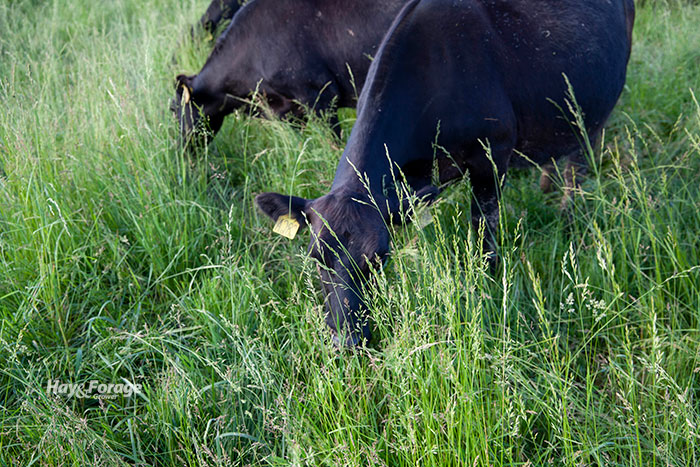The good, bad, and ugly of spring grass |
| By Mike Rankin, Managing Editor |
|
|
 The greening of America has begun, even for the Northern states. The spring flush of grass is a welcomed sight as the days of long underwear and frozen net wrap bid adieu. Although there is plenty of splendor to be gained from the flush of spring grass growth, there is also a heaping dose of challenges. “Spring pastures benefit from delayed grazing,” says Jeff Lehmkuhler, extension beef specialist with the University of Kentucky. “Much of the early growth will be supported by plant energy stores until sufficient leaf area has developed for photosynthesis. Continually removing this new growth could further weaken stands or slow spring forage growth,” he adds. Research has shown grazing grass species prior to the four-leaf stage will reduce season-long yields as much as 30%. Over the long term, the benefit of feeding cows to keep them off grass until it is ready will outweigh the cost of reduced grazing capacity. Frequent movement of cattle will also be beneficial to both cattle and grass. Giving grass some time to rest, especially as summer approaches, will enhance grazing capacity. Weakening pasture stands that will cost you throughout the summer is one thing, but there are also nutritional factors to consider. A lot of water “Early spring growth can be upward of 90% moisture,” Lehmkuhler says. “A cow requiring 30 pounds of dry matter intake would have to consume 300 pounds of actual grass due to the high-water content. Short and thin forage stands require cattle to expend a lot of energy walking fields for every blade of green grass to fill the rumen.” The Kentucky beef specialist points out that grazing is a high-energy activity, and that’s especially true for spring grazing. Some studies have shown that spring grazing requires twice the energy as summer grazing because of lower forage availability and less forage consumed per bite. Supplementing cows for energy and/or dry matter may be needed in early spring. The supplementation decision needs to be based on cow condition in relation to the breeding season. Nutritionally balanced cows, in good condition, can go into the grazing season and have no problem maintaining condition and cycling during the breeding season. Unfortunately, that is not always the situation. Thin cows often have trouble gaining enough weight on spring grass to cycle normally during the breeding season. It is not always guaranteed that cows will gain weight rapidly on very lush spring grass. In one University of Minnesota study, thin cows turned out on spring grass and supplemented with 3 pounds per head per day of dry distillers grains had similar conception rates to adequately conditioned cows not supplemented. Conversely, thin cows turned out on grass and not supplemented had conception rates 12% lower than adequately conditioned cows on grass. Provide hay Most extension beef specialists recommend supplementing high-quality hay to add more dry matter to the spring-grazing diet and improve nutritional status. “The high moisture content of the grass can limit dry matter intake,” Lehmkuhler says. “Cows will not eat much hay, but 5 pounds of dry hay intake is equivalent to approximately 40 pounds of lush pasture forage. Allowing access to hay can provide cows an opportunity to boost their daily dry matter intake.” Don’t wait too long Although an early entry into spring pastures has consequences, so does a late one. Most experts agree that waiting too long will quickly put you behind right at the start. Rather, it’s generally recommended to begin grazing early but with two big caveats . . . offer larger areas and keep the animals moving. Both are needed to prevent overgrazing that will be detrimental to subsequent production. Long-time grazing consultant Jim Gerrish likes to turn out at the two- to three-leaf stage of grass development. Others have suggested when grasses are about 6 inches tall. The grazing strategy that Gerrish uses to minimize the effect of an explosive spring flush is to get cattle across all of his pastures twice in the first 45 to 60 days of the growing season. He moves cattle every day and offers fairly large areas, expecting to complete the first cycle in just 20 to 25 days. The second cycle is slower and takes 25 to 35 days to get around the paddocks. The objective is to make cattle take a little deeper bite to remove elongating stems. Gerrish explains that when undeveloped seedheads are being elevated from the base of the plant, they are highly nutritious and palatable. As the paddocks are made progressively smaller and stock density increases, there is more of a likelihood that grazing stock will remove the undeveloped seedheads. By having the developing seedheads within the stem removed, new tillers are initiated, and these will result in vegetative growth for later in the season. By using this approach, Gerrish reports he has been able to keep seedhead production to just 10% to 20% of the tillers that were vernalized over winter. Once grass growth begins to get ahead of consumption, start skipping paddocks that can be used for hay production. This hay can then be used for supplementing summer pastures or fed during the winter. Managing spring grass growth is rarely easy, but having an effective plan in place will optimize both cattle and grass production for the remainder of the season. |
